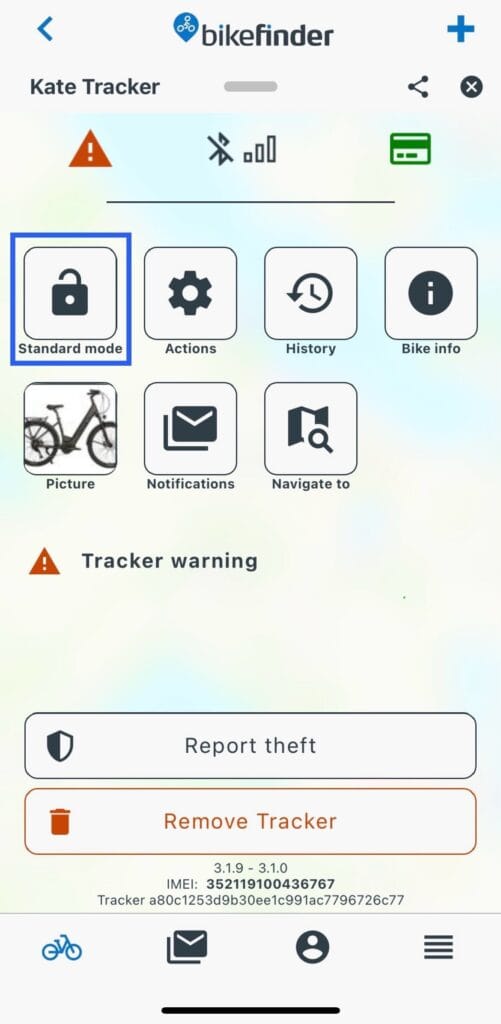Understanding How Your Tracker Works
How to change tracker modes?
There are different modes for the Bikefinder tracker in order to locate your bike.
Read about them to understand how the tracker works.
1. Click on the tracker in the BikeFinder application
2. Navigate to ”Modes” icon
3. Select the mode you wish to use



The new mode will first take effect when timer from last used mode runs out.
We recommend standard or security mode for normal use.
The different modes explained
Tracking mode
• Important: Battery life is short. It’s less than 16 hours, depending on when you charged it the last time, and the current battery level.
• Recommended: Tracking mode is only to be used when tracking your stolen bike, or while testing.
• In this mode, your tracker will send GPS positions as often as per minute.
• Your current positions are shown in the Bikefinder application, and the older positions are shown in ”History”.
• You will not get any push notifications in the app when your tracker is put in tracking mode.
Security mode
• Battery life: Medium – up to two weeks.
• Insurance is valid while in this mode.
• In this mode, the tracker will send a position every 10 minutes when movement’s detected.
• In this mode you get push notifications in your BikeFinder application when there is 20% and 40% battery capacity left, and when the bike has been moved.
• After giving a position, the tracker will sleep for 10 minutes, and will not react to any movement or give any notification, until the timer runs out.
• Tracker will send a position every 24 hours if there is no movement.
➣ Enable notifications
➣ About the movement sensor
Standard mode
• Battery life: Medium – up to 2 weeks.
• Insurance is valid while in this mode.
• This mode is the same as Security mode, except from no push notification on movement.
• The tracker can send a position every 10 minutes when movement’s detected.
• After giving a position, the tracker will sleep for 10 minutes, and will not react to any movement or give any notification until the timer runs out.
• Tracker will send a position every 24 hours if there is no movement.
Passive mode
• Battery life: Long – up to 8 weeks.
• Important: Insurance is not valid while in this mode. You must change back to a standard or security mode before theft takes place, and make sure tracker is online.
• This mode is made for disabling GPS to save battery for when you are out biking.
• Tracker only gives a GSM location every 20 minutes when movement’s detected.
• After giving a position, the tracker will sleep for 20 minutes, and will not react to any movement until the timer runs out.
• Tracker will send a GSM position every 24 hours if there is no movement
Remember that different factors may affect the battery’s lifetime, like consumption and temperature.
We advise you to read our article about battery and charging.
➣ Battery and charging
The different signal types (GPS, GSM, LTE-M, NB-IoT AND BLE) explained
The BikeFinder tracker uses different types of position signals, depending on the tracker mode set.
Below we provide you with a short summary of the different signal types, but feel free to read more about them here.
GPS (Satellite signal)
• This is the most accurate location tracker signal. It’s down to 10 meters accuracy anywhere in the world where it can receive the signals.
• It requires that Bikefinder can communicate with the satellites in space, and therefore, obstacles like thick concrete walls will affect the signal quality.
• GPS demands a lot of battery, and therefore has sleeping cycles in Bikefinder’s Standard and Security mode to save battery.
GSM (G1 tracker) /LTE-M & NB-IoT (Gen 2 tracker) (Cellphone signals)
• These signal types are useful when there are no GPS signals.
• They need Cellphone-Antennas nearby and have accuracy down to 2500 meters.
• If you need to find your bike, they will give a rough localization. This is not the most precise signal.
• Power consumption: high
Wi-Fi (radio signal) (Gen2 tracker only)
• This signal type is useful when there are no GPS signals.
• It needs a Wi-Fi router or access point nearby and have accuracy down to 5-50 meters.
• If you need to find your bike, it will give a rough localization.
• Power consumption: high
BLE/Bluetooth (Communication between your smartphone and the Bikefinder)
• The BLE position will automatically connect and update on your smartphone when the Bikefinder is within 60 meters. Make sure that your phone allows the BikeFinder application functions through phone settings.
• You can use the application to locate the Bikefinder using the BLE live distance counter.
• Power consumption: very low

Move on to next step (step 5) here, if you have a subscription with insurance.
BikeFinder Support [email protected]
Suggestions on how to improve this article?
Please submit a ticket below